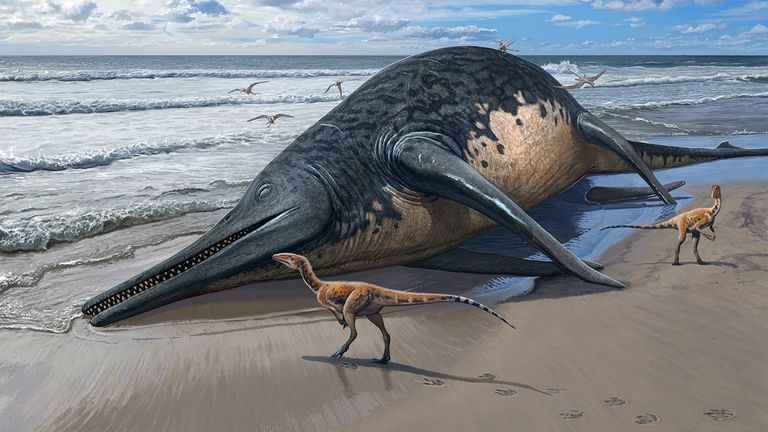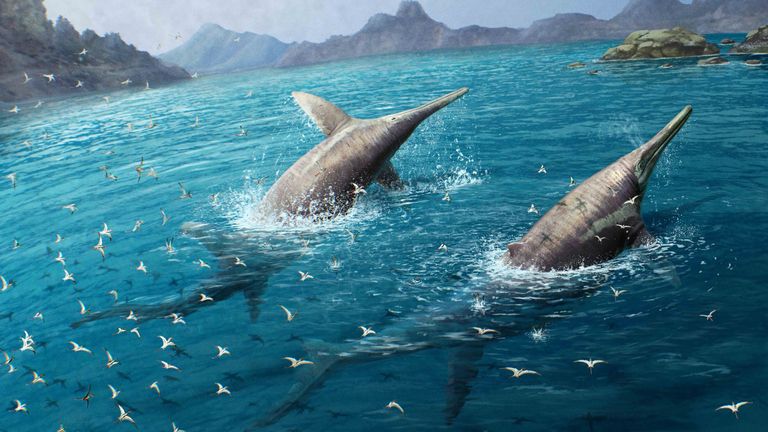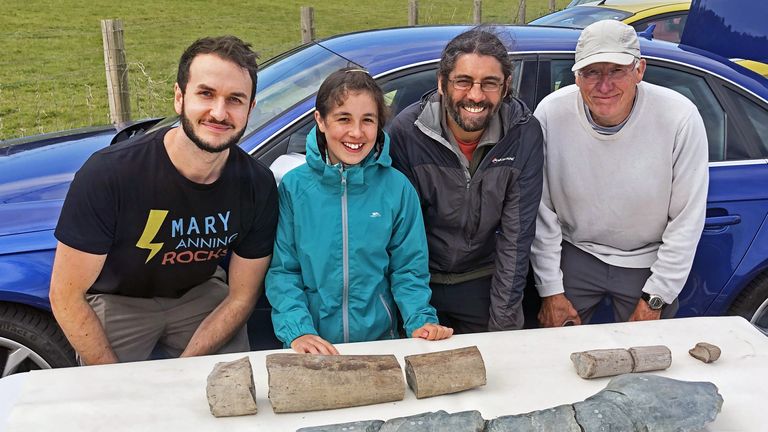British father and daughter discover bone of what may be largest known marine reptile
Justin and Ruby Reynolds found the fossilised remains of the prehistoric ichthyosaur on a beach in Somerset in May 2020.
Wednesday 17 April 2024 23:48, UK
A father and daughter from Devon have discovered part of what may be the largest known marine reptile.
Justin and Ruby Reynolds from Braunton discovered the fossilised remains of a gigantic jawbone measuring more than two metres long on a beach in Somerset in May 2020.
The bones belong to the jaws of a species of enormous ichthyosaur, a type of prehistoric marine reptile.
Experts estimate that the giant creature would have been more than 25m long - making it possibly the largest marine reptile ever recorded.
Piecing together the reptile
Mr Reynolds and Ruby, then 11, found the first pieces of the second jawbone while hunting for fossils on the beach at Blue Anchor.
The duo then searched together for more pieces and contacted Dr Dean Lomax, a palaeontologist at The University of Manchester. He then contacted Paul de la Salle, a seasoned fossil collector who had found the first giant jawbone in May 2016 further along the coast at Lilstock.
Over time, the team - including the father-daughter duo - found more pieces of the same jaw that fit together perfectly.
The last piece was discovered in October 2022.
New species about the size of a blue whale
Led by Dr Lomax, the researchers revealed that the jawbones belong to a new species of giant ichthyosaur that would have been about the size of a blue whale.
The team named the creature Ichthyotitan severnensis, which means giant fish lizard of the Severn.
Dating to the end of the Triassic period in a time known as the Rhaetian, the bones are about 202 million years old.
Gigantic ichthyosaurs swam the seas during this time, while the dinosaurs walked on land.
But rock and fossil records suggest that after the Late Triassic global mass extinction event giant ichthyosaurs became extinct, meaning the bones discovered in the study represent the very last of their kind.
Mr Reynolds said: "When Ruby and I found the first two pieces we were very excited as we realised that this was something important and unusual.
"When I found the back part of the jaw, I was thrilled because that is one of the defining parts of Paul's earlier discovery."
Read more from Sky News:
Hugh Grant settles case against The Sun
Post Office boss 'exonerated' after investigation
10 cities you'll need to pay tourist tax in
Ruby added: "It was so cool to discover part of this gigantic ichthyosaur. I am very proud to have played a part in a scientific discovery like this."
Dr Lomax said: "I was amazed by the find. In 2018, my team including Paul de la Salle studied and described Paul's giant jawbone and we had hoped that one day another would come to light.
"This new specimen is more complete, better preserved, and shows that we now have two of these giant bones - called a surangular - that have a unique shape and structure.
"I became very excited, to say the least."
He added: "I was highly impressed that Ruby and Justin correctly identified the discovery as another enormous jawbone from an ichthyosaur.
"They recognised that it matched the one we described in 2018. I asked them whether they would like to join my team to study and describe this fossil, including naming it.
"They jumped at the chance. For Ruby, especially, she is now a published scientist who not only found but also helped to name a type of gigantic prehistoric reptile."
Be the first to get Breaking News
Install the Sky News app for free


He added: "There are probably not many 15-year-olds who can say that. A Mary Anning in the making, perhaps."




